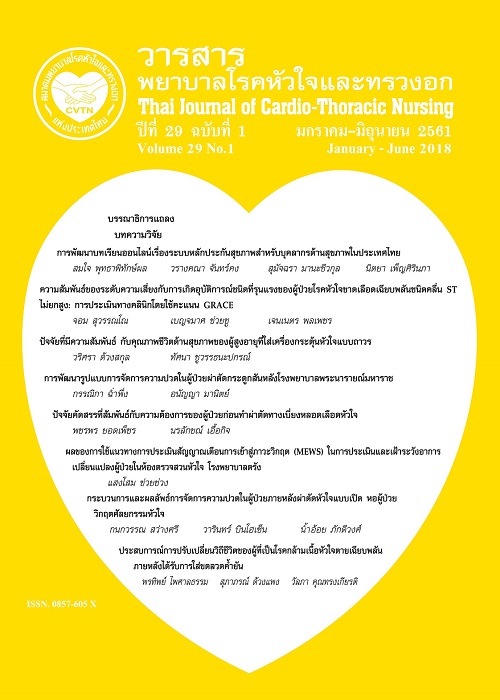ความสัมพันธ์ของระดับความเสี่ยงกับการเกิดอุบัติการณ์ชนิดที่รุนแรงของผู้ป่วยโรคหัวใจขาดเลือดเฉียบพลันชนิดคลื่น ST ไม่ยกสูง: การประเมินทางคลินิกโดย ใช้คะแนน GRACE
คำสำคัญ:
โรคกล้ามเนื้อหัวใจขาดเลือดเฉียบพลันชนิดคลื่น ST ไม่ยกสูง, การประเมินความเสี่ยงด้วย เครื่องมือ GRACE, อุบัติการณ์ชนิดที่รุนแรงจากสาเหตุโรคหัวใจและหลอดเลือดบทคัดย่อ
ผู้ป่วยโรคกล้ามเนื้อหัวใจขาดเลือดเฉียบพลันชนิดคลื่น ST ไม่ยกสูง มีความเสี่ยงสูงต่อการเกิดอุบัติการณ์ชนิดที่รุนแรงทั้งในระยะเข้ารักษาและหลังจากจำหน่ายออกจากโรงพยาบาล การวิจัยเชิงบรรยายนี้ ศึกษาความสัมพันธ์ระหว่างระดับความเสี่ยง กับการเกิดอุบัติการณ์ชนิดที่รุนแรงจากสาเหตุโรคหัวใจและหลอดเลือดของผู้ป่วยโรคกล้ามเนื้อหัวใจขาดเลือดเฉียบพลันชนิดคลื่น ST ไม่ยกสูง (NSTEMI) โดยใช้โมเดลคะแนนความเสี่ยง Global Registry of Acute Coronary Events (GRACE) ของ Otago-Southland เป็นเกณฑ์จำแนกระดับความเสี่ยง รวมรวมข้อมูลจากบันทึกเวชระเบียนของผู้ป่วยทั้งหมดจำนวน 176 ราย ซึ่งเข้ารักษาตัวในโรงพยาบาลชุมชนขนาด 170 เตียงแห่งหนึ่ง ตั้งแต่ วันที่ 1 มกราคม 2556 ถึง 30 มิถุนายน 2558
ผลการวิจัย พบอัตราการตายในโรงพยาบาล ร้อยละ 9.09 การตายในช่วงเวลา 6 เดือนแรกหลังจำหน่ายออกจากโรงพยาบาล ร้อยละ 14.37 และการตายรวม ร้อยละ 22.16 อัตราเสี่ยงการตายในโรงพยาบาลเพิ่มขึ้นในกลุ่มคะแนนความเสี่ยงปานกลาง (OR = 1.63, 95% CI 0.08-32.92) และความเสี่ยงสูง (OR = 7.86, 95% CI 0.45-138.71) เมื่อเทียบกับกลุ่มความเสี่ยงต่ำ เช่นเดียวกับการตายในช่วงเวลา 6 เดือนแรกหลังจำหน่ายจะเพิ่มขึ้นในกลุ่มคะแนนความเสี่ยงปานกลาง (OR = 2.46, 95% CI 0.29-20.89) และความเสี่ยงสูง (OR = 4.00, 95% CI 0.48-33.08) และการตายโดยรวมเพิ่มขึ้นในกลุ่มคะแนนความเสี่ยงปานกลาง (OR = 3.20, 95% CI 0.39-26.21) และความเสี่ยงสูง (OR = 8.33, 95% CI 1.05-66.23)
การจำแนกผู้ป่วยตามคะแนนความเสี่ยงจะเป็นข้อมูลสำหรับคาดการณ์ผลลัพธ์ทางคลินิก รวมทั้งการพิจารณาเลือกวิธีการรักษาและการติดตามผู้ป่วยให้สอดคล้องกับความเสี่ยงของผู้ป่วยแต่ละราย
เอกสารอ้างอิง
2. Tang EW, Wong CK, Herbison P. Global Registry of Acute Coronary Events (GRACE) hospital discharge risk score accurately predicts long-term mortality post acute coronary syndrome. Am Heart J. 2007;153(1),29-35.
3. Fox KAA, Dobbous OH, Goldberg RJ, Pieper KS, Eagle KA, Van de Werf F, et al. for the GRACE Investigators. Prediction of risk of death and myocardial infarction in the six months after presentation with acute coronary syndrome: prospective multinational observational study (GRACE). BMJ. 2006;333:1091-4.
4. Fox KAA, Eagle KA, Gore JM, Steg PG, Anderson FA for GRACE and GRACE2 Investigators. The Global Registry of Acute Coronary Events 1999 to 2009-GRACE. Heart.2010;96(14):1095-101.
5. Fox KAA, FitzGerald G, Puymirat E, Huang W, Carruthers K, Simon T, et al. Should patients with acute coronary disease be stratified for management according to their risk? Derivation, external validation and outcomes using the updated GRACE risk score. BMJ Open. 2014;4(2): e004425.
6. Granger CB, Goldberg RJ, Dabbous O, Pieper KS, Eagle KA, Cannon CP, et al. Predictors of hospital mortality in the Global Registry of Acute Coronary Events. Arch Intern Med. 2003;163(19):2345-53.
7. Bentler PM, Chou C. Practical issues in structural modeling. Sociol Methods Res 1987;16:78-117.
8. Abu-Assi E, García-Acuña JM, Peña-Gil C, González-Juanatey JR. Validation of the GRACE risk score for predicting death within 6 months of follow-up in a contemporary cohort of patients with acute coronary syndrome. Rev Esp Cardiol. 2010;63(6):640-8.
9. Chan MY, Shah BR, Gao F, Sim LL, Chua T, Tan CH, et al. Recalibration of the Global Registry of Acute Coronary Events risk score in a multiethnic Asian population. Am Heart J. 2011;162(2):291-9.
10. Pieper KS, Gore JM, FitzGerald G, Granger CB, Goldberg RJ, Steg G, et al. Validity of a risk-prediction tool for hospital mortality: the Global Registry of Acute Coronary Events. Am Heart J. 2009;157(6):1097-105.
11. Baury AA, Kumbhani DJ, Gong Y, Handberg EM, Cooper-DeHoff RM, Pepine CJ. Simple integer risk score to determine prognosis of patients with hypertension and chronic stable coronary artery disease. J Am Heart Assoc. 2013;2(4):e00205.
12. Boersma E, Pieper KS, Steyerberg EW, Wilcox RG, Chang W, Lee KL, et al. for the PURSUIT Investigators. Predictors of outcome in patients with acute coronary syndromes without persistent ST-segment elevation: results from an international trial of 9461 patients. The PURSUIT Investigators. Circulation. 2000;101(22):2557-67.
13. Newby LK, Bhapkar MV, White HD, Topol EJ, Dougherty FC, Harrington RA, et al. for the SYMPHONY and 2nd SYMPHONY Investigators. Predictors of 90-day outcome in patients stabilized after acute coronary syndrome. Eur Heart J. 2003;24(2):172-81.
ดาวน์โหลด
เผยแพร่แล้ว
รูปแบบการอ้างอิง
ฉบับ
ประเภทบทความ
สัญญาอนุญาต
บทความนี้ยังไม่เคยตีพิมพ์หรืออยู่ในระหว่างส่งไปตีพิมพ์ในวารสารอื่น ๆ มาก่อน และกองบรรณาธิการขอสงวนสิทธิ์ในการตรวจทาน และแก้ไขต้นฉบับตามเกณฑ์ของวารสาร ในกรณีที่เรื่องของท่านได้ได้รับการตีพิมพ์ในวารสารฉบับนี้ถือว่าเป็น ลิขสิทธิ์ของวารสารพยาบาลโรคหัวใจและทรวงอก






